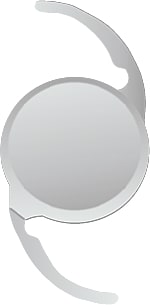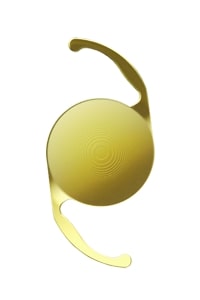What Are Premium Lenses?
Surgeons replace the natural lens of the eye with a traditional intraocular lens (IOL) or with what is called a premium lens for patients that are interested in this type of lense option. Premium IOLs are made with innovative biomaterial, aspheric (multifocal) design, and refractive properties that help distance, intermediate and close vision.

What Issues Can Premium Lenses Treat?
Historically, intraocular lenses had been implanted to replace a clouded lens affected by cataracts. The replacement lens provided vision clear of cloudiness but did nothing to reduce a person’s need for eyeglasses. Today’s intraocular lenses are made specifically to improve vision at various distances. Premium intraocular lenses can address refractive errors such as nearsightedness and farsightedness, as well as presbyopia and astigmatism.
Can a multifocal IOL be implanted in just one eye?
All cataract surgeries are performed on one eye at a time. If the patient needs cataract surgery in both eyes, the second procedure is scheduled a few weeks later to allow the first eye to fully heal.
Most people develop cataracts in both eyes, but they often don’t develop at the same rate. Some patients have one eye with a well-developed cataract and their other eye has a clear natural lens or only an early cataract. In this case, the patient may only need to have cataract surgery on one eye, and a multifocal IOL will be a great way to improve their vision. The premium IOL will act like the other natural lens, providing the ability to focus at all the different sight ranges. Plus, the vision will be crystal clear, which will be a nice change after living with the increasing cloudiness in the eye with the advanced cataract.
Intraocular Lens Candidates
Patients who visit one of our Boston area offices to discuss cataract removal or refractive lens exchange meet with an experienced ophthalmologist who will discuss medical history and individual needs and preferences for future vision. Our team has years of experience serving patients in our local area with a personal touch and the latest technical aspects of cataract and refractive surgeries. We develop a customized approach for each patient to achieve the most satisfactory outcome.
Our comprehensive consultation and examination seek to discover which type of lens will be most appropriate in each case.
What Are The Advantages Of Premium Lenses?
The primary reason why patients choose a premium IOL is that they want to retain multifocal vision. Where a standard IOL is referred to as monofocal (attaining a single-distance visual quality, such as up close or farther away), a premium IOL is made to focus well at numerous points and distances.
Premium IOLs:
- Can eliminate the need for eyeglasses, even for patients with more complex visual needs.
- Are suitable for patients with presbyopia, the age-related eye condition that can disrupt near vision. A premium IOL can correct near vision while simultaneously preserving distance vision.
- Provide a custom solution for each patient. No two people have the same exact vision needs. The wide selection of premium IOLs adequately meets the needs of patients with various lifestyle habits and preferences.
- Have a high satisfaction rate. Most patients who receive premium IOLs find that their level of visual improvement has a positive effect on daily living.
- Clear vision at all distances means less time spent fumbling with eyeglasses and greater ability to engage in an active lifestyle without the need for special eyewear.
Intraocular Lens Patient Testimonial
"Dr. Evans is a wonderful surgeon. I can’t praise him enough based on my personal experience. Thank you Dr. Evans for taking such good care of me."
I Have A High Amount Of Astigmatism. Can I Still Get A Multifocal IOL?
Yes. Today’s toric premium IOLs are made specifically to correct for astigmatism, even at higher levels of the condition. The companies behind these advanced premium IOLs (Alcon, Starr Surgical, Abbott Medical, and Bausch + Lomb) have online toric calculator tools to help determine the best model and the axis of orientation of the lens. At North Suburban Eye Associates, our surgeons will work with you to find the best toric IOL for your needs.
Multifocal IOL
Multifocal lenses are a popular choice for patients who do not want to depend on glasses. Although there is no guarantee of 20/20 vision, our patients are very happy with multifocal lenses because they often do not use distance, computer or reading glasses.

Toric IOL
Toric lens implants are a unique type of lens implant that are used to correct astigmatism. A Toric lens implant is NOT the only method of astigmatism correction, so consult a doctor about the current possibilities.
Asymmetric steepening of the cornea or natural lens causes light to be focused unevenly, which is the main optical problem in astigmatism. To individuals with uncorrected astigmatism, images may look blurry or shadowed. Astigmatism can accompany any form of refractive error and is very common. Astigmatism can be corrected with glasses, contact lenses, corneal relaxing incisions, laser vision correction, and special implant lenses.
If a cataract patient has astigmatism and has aspirations to be glasses-free for distance vision after surgery, the Toric lens implant is a good option. Toric lens implants are NOT a correction option for presbyopia.
What Is Astigmatism?
Asymmetric steepening of the cornea or natural lens causes light to be focused unevenly, which is the main optical problem in astigmatism. To individuals with uncorrected astigmatism, images may look blurry or shadowed. Astigmatism can accompany any form of refractive error and is very common.
How Is Astigmatism Treated?
Astigmatism can be corrected with glasses, contact lenses, corneal relaxing incisions, laser vision correction, and special implant lenses.

How To Choose The Right Premium Lens Implant
Premium lens implants can be very exciting for patients potentially looking for freedom of glasses or contact lenses after cataract surgery, or with clear lens extraction. Due to the complex nature of each person’s eyesight, eye health and everyday needs, it is difficult for a patient to assess the correct lens option for them. We suggest scheduling a consultation with one of our ophthalmologists to discuss cataract surgery and which lens implant is right for you.
Intraocular Lens Procedure
Lens replacement surgery may coincide with cataract removal or occur solely to correct a refractive error. In either situation, the procedure involves one of a few different techniques. The method of lens replacement that will take place is discussed prior to surgery and all patient questions are answered.
Cataract removal and lens replacement are outpatient procedures that are conducted with a local anesthetic. Medicated eye drops work very quickly to numb the nerve endings in the eye. A small device gently holds the eye open while the surgeon makes a tiny incision on the eye’s surface. Microsurgical instruments are used to remove the lens through this incision. The new lens is then inserted into the pocket. Many lens replacement procedures are conducted in less than an hour without any need for stitches to hold the new lens in place.
Will I see halos after having a lifestyle lens implanted?
Seeing halos is one of the symptoms of well-developed cataracts. They are also one of the symptoms of other conditions, such as glaucoma, migraine headaches, and even some LASIK surgeries.
They are also a side effect after having your cataract replaced with an intraocular lens. It is not unusual to experience glare and halos around lights during the first few weeks after your cataract surgery. In the vast majority of cases, these effects are mild and gradually disappear over the course of a few days to a few weeks. At roughly three months after your cataract surgery, swelling in the cornea will have settled along with any visual disturbances. Halos can linger in some rare instances.
How long do premium IOLs last?
All intraocular lenses, whether monofocal or these amazing premium lenses, are intended to last for the remainder of the person’s life. These lenses will not degrade or cloud in any way. They do not need to be replaced or cared for. These are single surgeries performed on the eye with the cataract.
Do IOLs Ever Have To Be Replaced?
Intraocular lenses rarely need to be replaced due to complications with the implant itself. Some patients (less than 1 percent) develop complications from cataract surgery, such as increased intraocular pressure or photosensitivity, which may require additional treatment. Even in these instances, the intraocular lens may be kept in place. Usually, if an IOL is replaced, it is to achieve a higher degree of visual acuity than is offered by the existing IOL.
Schedule A Consultation
If you are interested in cataract surgery and wish to learn more about premium intraocular lenses, contact us at 781-245-5200. We’re happy to schedule a consultation at a location near you.

